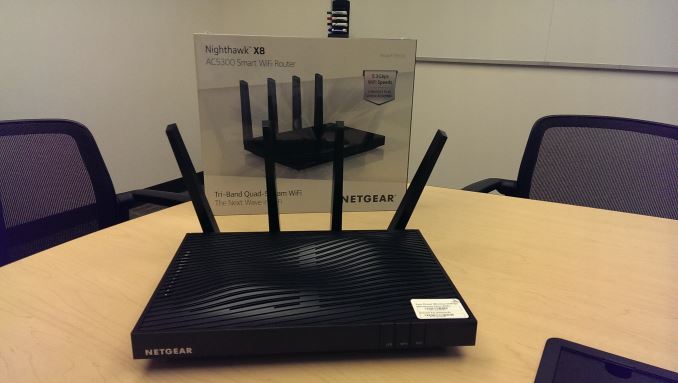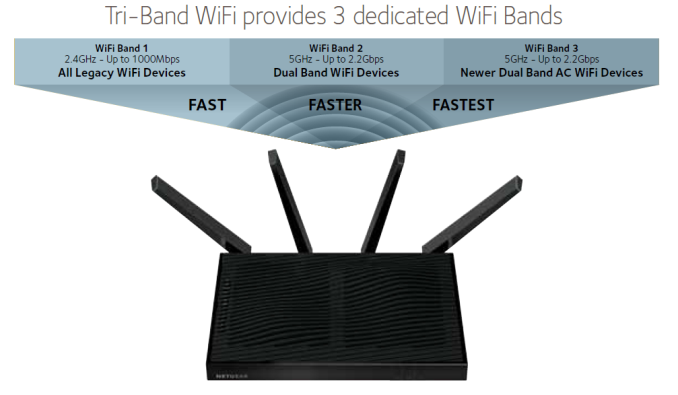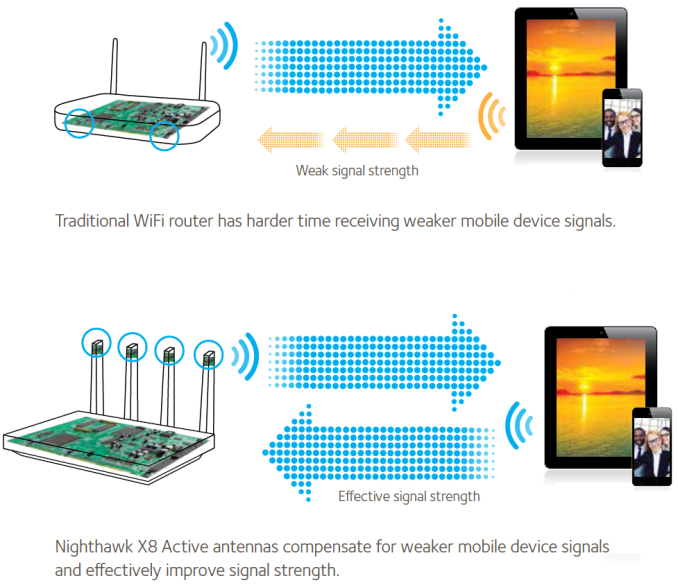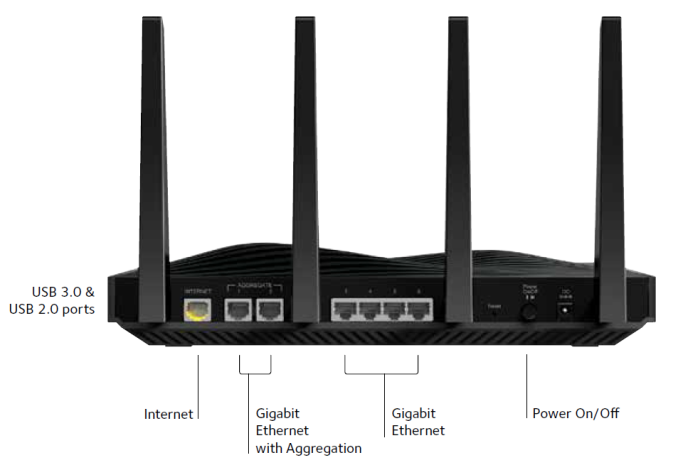Netgear Nighthawk X8 (R8500) Wave 2 802.11ac Router Set to Ship
by Ganesh T S on October 1, 2015 8:30 AM EST- Posted in
- Networking
- NetGear
- Broadcom
- 802.11ac
- Wi-Fi

Broadcom's XStream platform has enjoyed quite a bit of success in the Wi-Fi router market despite its high cost. The first generation XStream platform used a 3x3 configuration for each band, and lacked Wave 2 features such as MU-MIMO support or 160 MHz channels. At the 2015 CES, Broadcom updated their XStream product portfolio with the BCM4366, a 4x4 MU-MIMO capable radio that could work along with the BCM47094, a dual-core Cortex-A9-based network processor SoC. At the same time, D-Link also announced the DIR-895L AC5300 router based on that platform. Early last month, we also had Asus announcing the RT-AC5300U with the 4x4 tri-band XStream configuration. Unfortunately, none of these announcements came with a concrete ship date. Netgear was conspicuously silent about their plans with the new platform, even though they were the first vendor to come out with a product based on XStream Gen 1 - the Nighthawk X6 (R8000). Today, Netgear is announcing the Nighthawk X8 (R8500) based on the second generation XStream platform. Unlike the announcements from other vendors, the R8500 is available for purchase today.
As a recap, the tri-band Wave 2 XStream platform integrates two 4x4 5 GHz radios (at 2.1 Gbps each) and one 4x4 2.4 GHz radio (at 1 Gbps). The setup is capable of using 1024 QAM (Broadcom-proprietary NitroQAM, works only with clients having Broadcom Wi-Fi receiver chipsets) to boost performance. Most of the
Wi-Fi aspects have been covered in our D-Link and Asus router launch articles, and I won't go into detail here. Instead, the focus of this piece will be on the differentiating aspects in the Nighthawk X8.
The most striking aspect of the R8500 when compared to the other XStream Gen 2 routers is the presence of only four external antennae instead of eight. Netgear has opted to go for four external and four internal ones. Physical appearances aside, the four external antennae are all active ones. This is the first time that we are actually seeing active antennae being deployed - the Wi-Fi amplifiers are moved from their usual location in the router's motherboard to the top of the antennae. This reduces cross-talk on the board and also avoids signal loss in the transmission between the antennae and the board.
The other interesting feature is the availability of 6 LAN ports in addition to the WAN port (all GbE, obviously). Two of the 6 LAN ports come with 802.3addynamic link aggregation support in-built into the firmware. For select devices (such as certain ReadyNAS models), connecting both wired ports to ports on the device will automatically configure everything to take advantage of the teamed link. For example, it will be possible for two different wired clients or multiple Wi-Fi clients to stream out simultaneously from the NAS and get more than 1 Gbps of effective throughput from the NAS.
Note the industrial design with two waves on the top of the chassis - indicative of a Wave 2 device
Like all other XStream Gen 2 products and Quantenna-based products, the MU-MIMO capability is present in the hardware, but the firmware to enable them will be made available later on. Netgear indicated it would be before the end of the year, but we wouldn't be surprised if it comes only after the Wi-Fi Alliance starts certifying MU-MIMO interoperability in 2016.
Other than the active antennae and link aggregation features, the R8500 comes with the standard value-adds that have been part of all the Nighthawk routers since the R7000 - beamforming, dynamic QoS (based on Broadcom's iQoS engine in the Broadcom-based routers and the Qualcomm Atheros StreamBoost engine in the Quantenna-based routers), VPN and DLNA support. All the XStream Gen 1 features in the R8000 (such as 'Smart Connect' to steer clients to the appropriate band) are carried over to the R8500. The router also comes with ReadyCLOUD USB Access, which enables secure access to any USB drive connected to the router over the Internet. Netgear also supplies ReadySHARE Vault, a PC program for backing up content to any USB drive attached to the router. Consumers loath to accessing a web UI to monitor / configure / repair their networks can also use the Netgear Genie app for this purpose.
The Nighthawk X8 R8500 AC5300 router is available for purchase today at an MSRP of $400.
Source: Netgear













29 Comments
View All Comments
nsfw777 - Wednesday, October 14, 2015 - link
This! Just give me a great AP and forget trying to make it a NAS, a media streamer, a 6 port switch. I too run pfSense and would rather spend my money on some Netgate hardware.Azurael - Thursday, October 1, 2015 - link
I'd like this hardware, combined with OpenWRT compatibility, in a far cheaper package. I'd also like the moon on a stick.Until then, the DIR-825 creaks on. I only ended my 200 days uptime record because I updated to a new build of OpenWRT. Every router running stock firmware I've ever owned has needed to be rebooted at least once a week and had compatibility issues with certain systems/wireless cards... Then there's the fact that after 6 months or so, they won't bother with any more firmware patches for the functionality that's probably been broken since release. Router manufacturers, alongside printer manufacturers, IMHO, are the biggest shysters in the computer industry. I wouldn't buy any of their products if I didn't have to. Which is why I'm using a 6 year old 'Draft N' router still :P
azazel1024 - Thursday, October 1, 2015 - link
Now, I don't disagree on generally poor firmware support, but both of my Netgear 3500Lv1 ran like a champ for years. One finally needed reboots every 2-3 days as DHCP and the admin console would fail, the other one was working fine when I got rid of it (about 3 years for both). All of my TP-Link routers have been running strong. My Archer C8 has required exactly one "problem" related reboot in about a year or use, Archer C5 (6 months?) I think one reboot because of a wireless performance issue, zero reboots so far and WDR3600 (2) about 2 1/2 years of no reboots.For one of those WDR3600 it has been running sitting in my garage in temperatures from 0-102F working like a champ.
All have used OEM firmware (also TP-Link, though not great, seem to run firmware patches for at least 24 months and I've seen the occasional patch 3-4 years out from when they first started shipping the device).
juhatus - Thursday, October 1, 2015 - link
Check http://www.asus.com/Networking/RTAC68U/HelpDesk_Do... they are on their 7th update this year for this 802.11ac first wave device, been running solid since I bought it. Just firmware related reboots and gets all wrt-based goodies with stock firmware.Impulses - Saturday, October 3, 2015 - link
I'm very happy with mine, and haven't even stayed up to date with firmware.Azurael - Wednesday, October 7, 2015 - link
Hmm, the first thing I see on there is that it took them 17 days after CVE listing to fix a serious RCE exploit... And that's a 'good' router manufacturer rather than say, Belkin.On that subject though, initially replying to this thread got me thinking about how much wireless has come on since the early days of draft-N, and I picked up a (funnily enough) Belkin F9K1115 specifically as it appeared to be the most affordable 3x3 AC router on OpenWRT's compatibility list. Faster NAS, faster torrent downloads (running on the router, that is), and much faster wireless. I guess even if their software sucks, it's worth picking up new hardware once in a while!
Thayios - Thursday, October 1, 2015 - link
My R8000 was garbage - I would have clients drop off the network communication wise while still being connected, even the RMA did the same thing and others reported the same issues (The single SSID 2 x 5 Ghz SSID was the issue).My R7000 has been solid, no issues what so ever after they released fixed firmware.
I won't ever trust Netgear again after the R8000 fiasco when it comes to first release hardware/software later support.
WJames65 - Thursday, October 1, 2015 - link
Strange. My R8000 has been rock solid. Typically, around 10 devices are connected and actively sending / receiving data. I have no disconnect issues at all, and video streaming is flawless.Thayios - Thursday, October 1, 2015 - link
It is very possible they finally fixed the issue via firmware or a hardware change. Did you have one of the first release ones?Stuka87 - Thursday, October 1, 2015 - link
I love my Nighthawk, best router I have ever had. For me, it was worth the cost.